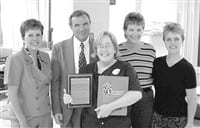Lessons in Smart Eating School’s Out, but It’s Still Time to Do Things by the Book
As parents we have a responsibility to set good examples for our children, and that includes at the dinner table.
A survey of members of the American Dietetic Assoc. found a widespread belief among dietetics professionals that parents as role models play the primary role in preventing excessive weight gain in children as Western Mass., and the nation as a whole, struggles with an unprecedented obesity epidemic.
The survey also found that dietetics professionals believe simple food-related activities, such as involving children in menu planning and food selection and preparation, are the most effective ways to guide their dietary habits. Also, eating together as a family is important.
Just last month, the job was made somewhat easier for parents who want to help their children adopt healthy eating habits. In June, the federal government introduced a new food icon called MyPlate, which replaces MyPyramid. The new food guide is a welcome change from the old pyramid, which many found confusing, and offers a more straightforward message about what a dinner plate should look like. The plate depicts the serving sizes of fruits and vegetables (at least half of the plate) paired with lean proteins and whole grains, along with an accompanying glass for low-fat dairy. If you normally serve your child whole milk, switch to 2{06cf2b9696b159f874511d23dbc893eb1ac83014175ed30550cfff22781411e5} for a couple of weeks, then down to 1{06cf2b9696b159f874511d23dbc893eb1ac83014175ed30550cfff22781411e5} fat, which still has the same amount of calcium, but is lower in fat and calories. To learn how to build a healthy plate of food for your child and yourself, visit www.choosemyplate.gov.
School’s Out
Now that the school year has ended and children are home for the summer, it is especially important to have structured activities planned each day so they are not just sitting in front of the television set. There needs to be a meal plan as well, so they don’t snack their way throughout the day. Say what you want about school lunches, but some research shows more kids gain weight over the summer months than during the school year because of increased snacking at home.
Parents should keep plenty of fresh fruits and vegetables at home for kids to snack on as opposed to chips and ice cream. Experiment with new fruits and vegetables in a variety of colors. Take your children grocery shopping with you and have them pick out one new fruit or vegetable to try each week. Also, try putting grapes in the freezer for a quick, fun, and cold snack, or make them a frozen strawberry fruit smoothie made with low-fat yogurt. And try to keep children from snacking from the box at home by keeping portions correct; portion out quarter-cups of snacks into little baggies for them.
Summer is the perfect time for kids to work on increasing their physical activity. According to the Centers for Disease Control and Prevention, children and adolescents should get at least 60 minutes or more of physical activity each day. Because the summer months are warmer than usual, children may be thirstier during all their activity. The problem is, many beverages carry extra calories. For example, just eliminating one soda per day and switching to water could equal about a 12-pound weight loss at the end of 12 months. Diet drinks are acceptable in reasonable quantities, including zero-calorie fruit waters or fruit seltzers. But watch out for soda waters, some of which have sodium. If you offer your child juice, it should be limited to one 4- to 6-ounce serving a day of 100{06cf2b9696b159f874511d23dbc893eb1ac83014175ed30550cfff22781411e5} juice. Overall, water is really the best choice for quenching your child’s thirst, and if you start to offer it as their main drink, you will find that they will soon make that choice, too, as they grow.
Menu of Choices
The summer months also mean traveling for many families and eating out more. But parents and children can still eat in moderation at a restaurant and watch their calories, too, because many restaurants now offer calorie counts on their menus. Skip the appetizer and dessert and just drink water as your beverage, then select a regular meal to treat yourselves or limit yourself to a healthier option. Also, because restaurants tend to super-size their portions, you can ask your server to place half of your meals in take-away containers before bringing your plates to the table.
If you’re not eating out, you may be enjoying a summer picnic or two between now and Labor Day, which can be made healthier by grilling low-fat turkey burgers or chicken or turkey hot dogs. Kids, however, love to overuse condiments such as ketchup or mayonnaise, some of which are high in fat, salt, and sugar. Try low-fat mayonnaise or no-fat dressings for salads, some of which taste quite good today. Newer salad sprays can help to reduce fat and calorie intake when eating a healthy salad. There are still many calories in low-fat dressing, so an even better choice might be to try making a low-fat yogurt mixed with spices as a substitute. And for corn lovers who like to drench those tasty ears with tons of butter or margarine, try using a low-calorie butter substitute spray.
Meanwhile, you don’t even have to travel very far for some family fun. Consider turning an adventure to a local farm or farmers’ market into a healthy learning experience. Introduce your children to the joy of picking their own fruit such as strawberries, blueberries, or raspberries as a way to include more fruit in their diet. Or use a visit to a local farmers’ market to introduce them to a new vegetable to add to their diet and to learn more about it from the farmer who grew it. More and more farmers’ markets are accepting SNAP (formerly known as food stamps), and some also offer double-value programs. Visit www.buylocalfood.org to locate the farmers’ market nearest you and their payment options.
For additional information, visit the food and nutrition section of www.usda.gov, which has easily accessible and understandable nutrition information for the entire family on your goal of adopting healthy eating habits and a healthier lifestyle. v
Dr. Chrystal Wittcopp is director of the Pediatric Weight Management Program Baystate Children’s Hospital. For more information about the program, visit baystatehealth.org and click on Baystate Children’s Hospital, then Specialties and Services, followed by Pediatric Weight Management Program.



